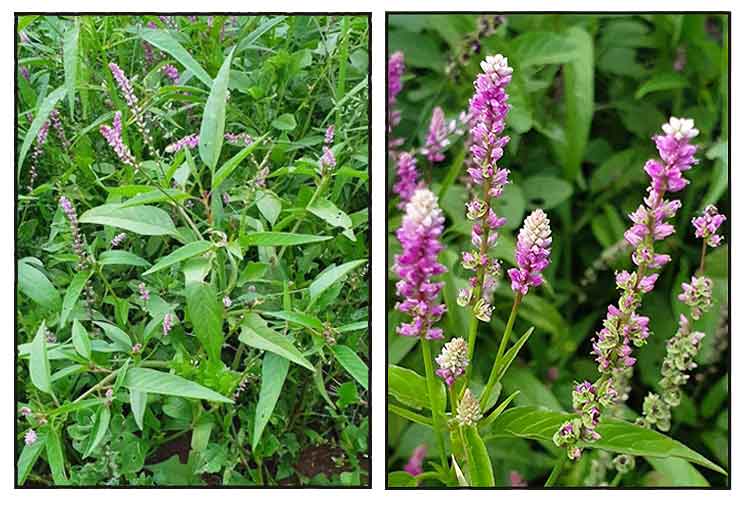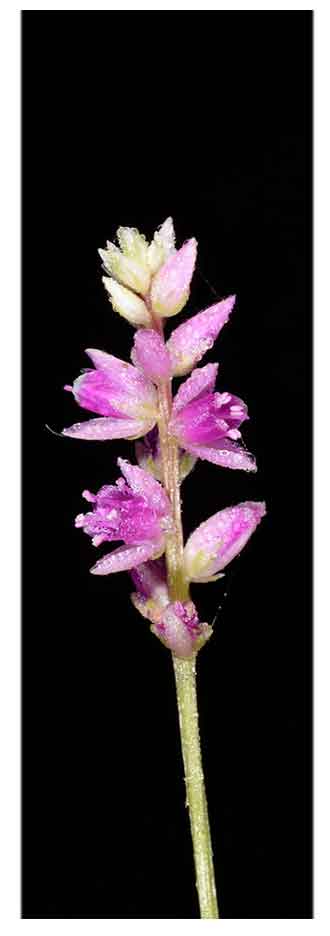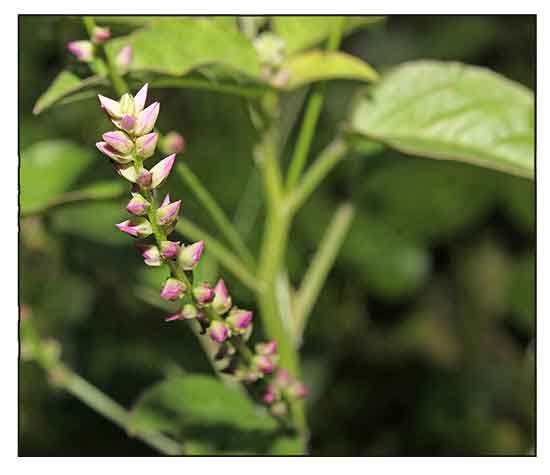 Gen info Gen info
- Digera muricata is a species of flowering plant in the family Amaranthaceae. It is the sole species in the genus Digera.
 Botany Botany
• Profusely branched herbs. Leaves 4 x 3 cm, ovate, apex acute; petiole to 3 cm. Spikes axillary, to 9 cm; bracts 1.5 mm, ovate, scarious; bracteoles 2, 2 mm, ovate; tepals 5, outer 3 larger, 3 mm, ovate, scarious; stamens 5, basally connate, filaments 1.5 mm; anthers 0.2 mm; ovary 0.5 mm, obovoid. Utricle 2 mm, ovoid; seed one. (India Biodiversity Portal)
• An annual herb up to 70 cm tall; stem simple or branched, subglabrous, ridged. Leaves alternate, simple; petiole up to 5 cm long; blade linear to ovate, 1–9 cm × 0.2–5 cm, base narrowed, apex acuminate, margin entire, subglabrous. Inflorescence a long-pedunculate (up to 14 cm long), axillary, spike-like bracteate raceme up to 30 cm long, each bract subtending a subsessile partial inflorescence with a central fertile flower and 2 sterile lateral flowers. Flowers are borne on slender spike-like racemes, which can be as large as 30 cm long. Flowers are hairless, white mixed with pink to carmine or red, usually becoming greenish-white in fruit. Flowering occurs in month of August and September. Fertile flower with 2 firm, boat-shaped outer perianth segments 3–5 mm long and 2–3 inner, slightly shorter, hyaline segments; stamens usually 5, free or slightly connate at base; ovary superior, 1 -celled, style filiform, up to 4 mm long, stigmas 2, divergent; lateral flowers consisting of accrescent antlershaped scales. Fruit is subglobose, hard, 2 mm in diameter, ridged, enclosed by the persistent perianth and falling together with the sterile flowers and bracteoles. (7)
Distribution
- Naturalized. (1)
- Native to Afghanistan, Assam, Bangladesh, Burundi, China Southeast, Djibouti, Egypt, Eritrea, Ethiopia, Gulf States, India, Jawa, Kenya, Laccadive Is., Madagascar, Maluku, Myanmar, Nepal, Oman, Pakistan, Saudi Arabia, Socotra, Somalia, Sri Lanka, Sudan, Sulawesi, Sumatera, Tanzania, Uganda, Yemen, (2)
Constituents
- Study of extracts from air dried coarse plant powder
yielded primary metabolites of proteins, carbohydrates, chlorophylls, amino acids, reducing sugar and lipids; secondary metabolites of phenols, flavonoids, alkaloids, terpenoid, saponins, and tannins. (7)
- Nutrient analysis of D. muricata yielded: Edible portion 56, ash value 3.54, moisture 83.8, protein 4.3 g/100g; Minerals (mg/100g): calcium 506, potassium 604, magnesium 232, phosphorus 63; Trace minerals (mg/100g): iron 17.72, zinc 0.57, copper 0.16, chromium 0.234, manganese 0.23; Vitamins (mg/100g): ascorbic acid 49, thiamine 0.10, total carotene 17.93, ß-carotene3.36.
(7)
- GC-MS study for bioactive molecules in the active fraction of D. muricata leaves yielded carbohydrates, proteins, steroids, amino acids, cardiac glycosides, coumarin, polyphenols, alkaloids, saponin, tannin, and flavonoids.
(see study below) (11)
- Aqueous (A). ethanol (E), and methanol (M) extracts of leaves yielded alkaloids, flavonoids (E), glycoside, amino acids, fatty acids, carbohydrates (AE), saponins (AE), proteins (A), phenolic compounds (EM), tannins (A), sterols (A), terpenoids, anthocyanins (M), leucoanthocyanins (AM), coumarins (M), and emodines. (see study below) (12)
Properties
- Studies have suggest anticancer, atheroprotective, antibacterial, antifungal, nephroprotective, antioxidant, antidiabetic, lipoxygenase inhibitory, hepatoprotective, hypogonadism protective, nutritional, antidiarrheal, analgesic, antidepressant properties.
Parts used
Leaves, shoots, roots, flower, seeds..
 Uses Uses
Edibility
- Considred a famine food because of rich source of nutrients.
-
Leaves used as potherb.
- In Kenya, popular as cooked vegetable amongst coastal tribes. Flowers are rich in nectar, sometimes sucked by children. (7)
-
In India, leaves made into curries or entire plant boiled in water and seasoned with salt and chili. (7)
Folkloric
- No reported folkloric medicinal use in the Philippines, (2)
- Roots are used as galactagogue. Roots used for treating kidney stones. Flower and seeds used for treatment of urinary discharges. (6)
- Leaves used for diabetes.
- Boiled root infusion used by mother after childbirth to improve lactation.
- Leaves and young shoots eaten to alleviate constipation. Leaf paste applied to wounds to prevent development of pus. (7)
Others
- Fodder: Sheep and goats use the plant as forage.
Studies
• Anticancer / Leaves: Study of evaluated the anticancer potential of D. muricata ethanolic leaf extract on MG-63 osteosarcoma cell lines using MTT assay. MTT assay showed dose-dependent cell death. Cell viability decreased with increase extract concentration. Cell viability was 89.98% at 25 µg/ml and 15.64% at 200 µg/ml concentration. Results suggest the leaf extract has good antiproliferative activity in MG63 cell lines, able to induce apoptosis. Study suggests potential as anticancer agent for treatment of osteosarcoma. (6)
• Atheroprotective: Study elucidated the atheroprotective property of Digera muricata extract in modulating the macrophage polarization and atherogenic responses stimulated by the synergistic effect of 7-ketocholesterol and bacterial lipopolysaccharide. The sitosterol-rich Digera muricata helped in attenuating atherosclerosis development via effective regulation of oxysterol-induced macrophage polarization mediators and their atherogenic responses. Study suggests inclusion of the plant in daily routine diet may immensely benefit the manifestation of cardiovascular ailments associated with an unhealthy lifestyle. (8)
• Antimicrobial Novel Phytosterol: Study isolated a biologically active phytosterol from D. muricata and was characterized by antimicrobial assay and molecular docking. The isolated phytosterol (50 µl) showed maximum antimicrobial potential against Streptococcus pyogenes (ZOI 20.0), followed by Streptococcus agalactiae (ZOE 11.3), Candida albicans (ZOI 09.0), Klebsiella pneumonia (ZOI 8.6) and Escherichia coli (ZOI 8.6). (9)
• Nephroprotective / Carbon Tetrachloride Toxicity: Generation of reactive radicals have been implicated in carbon tetrachloride-induced nephrotoxicity, which are involved in lipid peroxidation, accumulation of dysfunctional proteins, leading to kidney injuries. Study evaluated the effect of D. muricata (5 mg/kbw)on CCl4-induced renal injuries. CCl4 treatment significantly increased levels of urine creatinine, protein, nitrite, urobilinogen, RBS, leucocyte count, and levels of BUN and decreased levels of antioxidant enzymes (catalase, peroxidase, SOD) and reduced GSH. Treatment with n-hexane and methanol extracts of D. muricata (200 and 250 mg/kbw, orally, respectively), effectively attenuated the alterations in biochemical markers, telomerase activity was inhibited and confirmed restoration of normalcy. (10)
• Antimicrobial / Leaves: Study evaluated D. muricata leaves extract for primary and secondary metabolites and antimicrobial potential by disc diffusion method. The ethyl acetate extracts showed significant antimicrobial potential against Streptococcus agalactiae (ATCC13813), Klebsiella pneumoniae (MTCC432), Escherichia coli (MTCC730), Streptococcus pyogenes (MTCC1924), Macrophomina phaseolina, and Candida albicans (MTCC7315). (see constituents above) (11)
• Antioxidant / Roots: Study evaluated the antioxidant activity of D. muricata root extracts using various in vitro assays i.e., DPPH. superoxide radical, hydroxyl radical scavenging, metal chelating, reducing power calculation and total phenolic content. The methanolic extract showed highest antioxidant activity for various assays, with total phenolic content of 38.22 mg/g gallic acid equivalent. Significant correlation was found between TPC and invitro assay indication phenolic acids may be major contributors for the antioxidant activity. (12)
• Cytotoxic / Leaves: Study evaluated the cytotoxic activity of ethanolic leaf extract of D. muricata on lung cancer cell line (A549) by MTT assay. The extract showed dose dependent cytotoxic potency against A549, and significantly reduced cell viability when concentration was increased for 24 hours. IC50 was observed at dose of 50 µg/ml. DAPI straining showed condensed chromatic and fragmented nuclei in treated lung cancer cells. Results showed treated significantly inhibited cell proliferation and induced apoptosis in lung cancer cells. (13)
• Antidiabetic / Leaves: Study evaluated various extracts of D. muricata and Amaranthus cruentus. Presence of polyphenol and antioxidant constituents such as flavonoids showed ability to reduce blood glucose levels. The methanol extract of D. muricata showed more effect on alpha-amylase than A. cruentus by invitro analysis. Digera muricata showed maximum inhibition of enzyme with 74.7% at 100 mg/ml concentration. The ME showed highest IC50 at 59.45 for α-amylase. Results showed potential for an anti-diabetic drug with no side effects. (see constituents above) (14)
• Cytotoxic Against Prostate Cancer Cell Lines / Leaves: Study evaluated the cytotoxic effects of D. muricata leaf extract using MTT assay against prostate cancer (PC-3) cell line. The MTT assay showed decreased cell vitality with increased concentration of leaf extract. Morphological study showed decreased number of cells after treatment, with cell shrinkage and cytoplasmic membrane blebbing. Treated cells also showed condensed chromatin and nuclear fragmentation. Results suggest the leaf extract was cytotoxic and induced apoptosis to cancer cells. (15)
• Gold Nanoparticle / Antibacterial: Study reports on the eco-friendly synthesis of gold nanoparticles using crude ethanol extract of D. muricata. The gold nanoparticles exhibited greater antibacterial potential than the crude ethanol extract against different drug-resistant bacterial including Vibrio cholera, Staphylococcus pyrogen, Klebsiella, Citrobacter, and Enterobacter. (16)
• Zinc Oxide Bionanoparticle / Antimicrobial / Lipoxygenase Inhibitory: Study reports on the simple and ecofriendly synthesis of ZnO nanoparticles (ZnO NPs) using D. muricata as reducing agent. ZnO NPs enhanced the activity of plant extracts against all employed antibacterial (E. coli, S. faecalis, P. aeruginosa, K. pneumonia, S. aureus, and B. subtilis) and fungal (T. mentagrophytes, E. flocossum, A. niger, M. canis, and F. culmorums) strains. The antifungal and antibacterial activities of the extracts were enhanced by the formation of ZnO NPs. Results indicated the ZnO NPs have more potent antimicrobial activity than the plant extract and showed similar inhibition against lipoxygenase with IC50 of 83.82, comparable to standard. (17)
• Fertility Effects / Antioxidant / Aerial Parts: Study evaluated n-hexane extract of D. muricata aerial parts (DMH) for antioxidant and fertility effects in Sprague-Dawley male rats. An earlier study showed CCl4 administration caused testicular atrophy, degeneration of germinal layer, decrease in gonadotropins (FSH, LH( and increase in prolactin and estradiol in male rat. Treatment restored suppressed level of testosterone, luteinizing hormone (LH) and follicle stimulating hormone (FSH). Treatment with DMH attenuated the toxicity of CCl4, and the decrease in weight of body, liver, testis, accessory organs reversed towards normal level. Results suggested protective potential of DMH against CCl4-induced liver toxicity and testicular toxicity. Presence of bioactive constituents, rutin and hyperoside in DMH were suggested to have therapeutic effects against CCl4 induced oxidative stress and hypogonadism. (18) Study evaluated the effect methanolic extract of D. muricata (DME) against CCl4-induced toxicity in male rats. Results suggest ability of DME to ameliorate CCl4-induced testis injury, attributed to its antioxidant and ROS scavenging properties. Data supports use of D. muricata in secondary infertility. (19)
• Incorporation of Leaves into a Nutritional Product Soup: Study evaluated the incorporation of D. muricata leaves rich in fat (1.01 mg/100g), protein 2.48 mg/100 gm) and iron (15.80 mg/100gm) as supplement in vegetable soup with four levels viz., 2.5, 5, 7.5 gm and control, measured in sensory parameters of color, appearance, flavor, texture, and taste and overall acceptability score. The supplementation of 7.5 gm of D. muricata leaves was found most acceptable. (20)
• Analgesic / Antidiarrheal / Anti-depressant / Aerial Parts: Study evaluated a methanol extract of aerial parts of D. muricata and its partitionates for biologic activities. In acetic acid-induced writhing test, the crude extract conferred 63.48 and 66.09% protection at doses of 200 and 400mg/kbw, respectively, compared to 74.80% by standard diclofenac. In tail immersion test, the extract produced significant increase in pain reaction time, while in hot plate test, the extract dose-dependently increase pain reaction time. The extract inhibited castor oil-induced diarrhea in mice by 61.44 and 65.72%, respectively. In castor oil-induced enteropooling, extract produced dose-dependent reduction in intestinal weight and volume. Extract inhibited mice intestinal motility by 61.88% and 72.40%, comparable to antidiarrheal drug. Extract also shortened time for onset of sleep and prolonged the duration of phenobarbitone-induced sleep in mice. The antidepressant activity was comparable to reference drug diazepam. (21)
Availability
- Wild-crafted. |

![]()



 Gen info
Gen info

